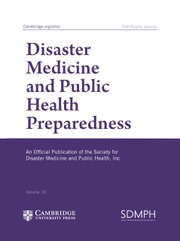No CrossRef data available.
Article contents
Fight or Flight: Emergency Health Care Workers’ Willingness to Work during Crises and Disasters. A Cross-Sectional Multicenter Study in the Netherlands
Published online by Cambridge University Press: 03 January 2025
Abstract
Expanding staff levels is a strategy for hospitals to increase their surge capacity. The aim of this study was to evaluate whether emergency health care workers (HCWs) are willing to work during crises or disasters, and which working conditions influence their decisions.
HCWs in the emergency departments (EDs) and intensive care units (ICUs) of 5 Dutch hospitals were surveyed about various disaster scenarios. For each scenario, HCWs were asked about their willingness to work (WTW) and which conditions would influence their decision. Knowledge, perceived risk, and danger were assessed per scenario.
A total of 306 out of 630 HCWs completed the survey. Influenza epidemics, SARS-CoV-2 pandemics, and natural disasters were associated with the highest WTW rates (69.0%, 63.7%, and 53.3%, respectively). WTW rate was lowest in nuclear incident (4.6%) and dirty bomb (3.3%) scenarios. WTW rate was higher in physicians than in nurses. Male ED HCWs, single HCWs, and childless HCWs were more often willing to work. Personal protective equipment (PPE) and the safety of HCWs’ families were the most important working conditions. Perceived knowledge scored lowest in the dirty bomb, biological, and nuclear incident scenarios. These scenarios were rated highest with respect to perceived danger.
WTW depends on disaster type, profession, and department. The provision of PPE and the safety of HCWs’ families were found to be the predominant favorable working conditions.
- Type
- Original Research
- Information
- Copyright
- © The Author(s), 2025. Published by Cambridge University Press on behalf of Society for Disaster Medicine and Public Health, Inc


